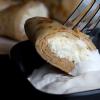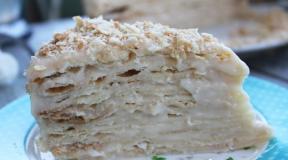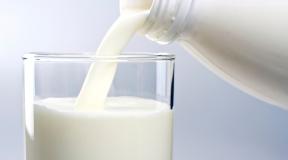Where does the most delicious tropical mango grow? General benefits of mango How many calories, vitamins and nutrients are in mango?
The fruit of Mangifera indica or Indian mangifera - mango - is becoming more and more popular among Russian connoisseurs of exoticism. We buy a mango in a supermarket, unaware of the fact that in India and Pakistan it is called the Asian apple by analogy with the fruit with which Eve tempted Adam. True, an Asian legend says that the god Shiva raised a magnifer with its wonderful fruits for his beloved. As a sign of his love, Shiva gave his beloved this tree. Nowadays, Mangifera indica is considered the national symbol of India, it is also revered in Pakistan.
Today we want to talk a little about mango, let's talk about the beneficial properties and contraindications of mango, how this fruit is used in medicine and for weight loss.
What kind of fruit?
Mango is cultivated in India, Thailand, Guatemala, Mesquica, Spain, Pakistan and other countries with hot climates. Ripe fruits of green, yellow, purple and even black colors are scattered all over the world. More than 20 million tons of Asian apples are sold by lovers of this fruit. There are about 300 species of mango in the world, a little more than 35 varieties are cultivated - hence such a variety of colors. This makes it difficult to determine the ripeness of the fruit, because, for example, the green mango fruit may be more ripe than the orange one.
However, there are still ways to navigate the ripeness of the mango: in the area of the stalk, the fruit should emit a pleasant fruity smell, and when pressed, it should be elastic. The mango skin should be smooth and shiny. If the smell near the stalk is a bit like the smell of turpentine - the fruit is not spoiled, it's just such a variety, however, it is less valuable than others.
If, nevertheless, with all diligence, it was not possible to buy a ripe mango fruit, it does not matter. In India, for example, it is eaten at almost all stages of ripeness. Alternatively, you can ripen the mango by wrapping it in dark paper and placing it in a dark, warm place for one week. In the refrigerator, the ripening process slows down or stops altogether. However, with prolonged storage in the cold, the pulp of the fruit may soften and become unpalatable.
Useful properties and composition
All the benefits of mango for the body are due to its rich and unique composition. Mango is rich in vitamins A, B, C, D and E. Moreover, the content of vitamin C can reach up to 175 mg per 100 g of fruit pulp. In addition, there is a very high content of such sugars as sucrose, xylose, glucose, sedoheptulose, fructose, maltose, mannoheptulose.
Mango is rich in amino acids, which are called essential - these are those amino acids that the human body cannot produce, so it must get them from food. As you might guess from the bright yellow or orange flesh of the mango, it is high in carotenoids. In fact, there are about 5 times more of them here than in the most orange tangerines.
Minerals that make up the wealth of mango fruits: calcium, phosphorus, iron. This is enough to say that the Asian apple has a rich mineral composition.
The peel and leaves of the mango tree contain tannins; there is also a powerful herbal tranquilizer in the leaves.
The benefits of mango

In India, which is rich in traditional medicine traditions, mangoes are used to treat many diseases. The combination of vitamins and minerals in it makes it possible to use it to prevent cancer of various organs, mainly in the reproductive and genitourinary spheres.
Another plus in favor of mango: vitamins of group B, vitamin "C" in combination with carotene help to strengthen the body's immune system, and also create protection of healthy cells from oxidation, because are antioxidants.
It is also believed that mango can quickly relieve nervous tension, easily improve mood, help overcome stress, and significantly increase the sexual abilities of partners.
Unripe mango fruit, consumed with honey and salt, is beneficial for diarrhea, chronic dyspepsia, dysentery, constipation and hemorrhoids. And to prevent bile stagnation, you should eat 2 of the same mangoes with pepper and honey.
Ripe fruits, as a valuable source of vitamin A, are very useful for night blindness and other eye diseases.
The use of mango in medicine
Mango leaves are used in the form of decoctions to improve vision in diabetes, as well as to treat diabetes itself. The same broth is useful for strengthening the cardiovascular system and treating the pancreas. If you have varicose veins, multiple hemorrhages on the skin, you should also try drinking a decoction of mango leaves.
In Asian medicine, mango fruits are considered very useful and they are even cured for cholera and plague. Ripe fruits have diuretic and laxative properties, are used for better blood clotting in case of internal bleeding. Mango juice is useful for acute dermatitis; seeds are used for asthma.
As a prophylactic agent, mangoes are used for better assimilation of meat dishes, to prevent heartburn.
Who is the fruit contraindicated for?
Contraindications for the use of mango can be divided into three groups:
- mango peel can become an allergen for some people, but the fruit itself can be eaten. Therefore, it is better to peel mangoes with gloves.
- Unripe mango fruits, if overeat, can lead to colic, irritation of the mucous membranes of the stomach and respiratory tract.
- ripe fruits, consumed in large quantities, can cause constipation, a clogged stomach, fever, and hives.

Slimming mango
Not many people know that the mango fruit has powerful dietary properties.
Without harm to health, you can reduce weight with the help of mango milk, which is considered very balanced. The fact is that mango is an excellent source of sugars, but it has no protein at all. Milk, which is rich in proteins, contains just a few sugars. Therefore, the combination of mango and milk gives a complete symbiosis of food for nutrition.
So, during the day, eat very ripe and soft mango fruits with plenty of milk. There are no exact recommendations here, because everything depends on the individual characteristics of a person and the reaction of his body. However, the combination of mango and milk should be observed: 3-4 kilograms of mango fruit and 4-5 liters of milk.
The tropical mango fruit is no longer a gimmick on our table. Tinned in wedges or fresh, freshly peeled mangoes, many have come to taste due to its juicy, sweet pulp and the beneficial properties it possesses. However, it is not recommended to eat it in large quantities. Why? Let's see how the mango tree fruit is useful, what benefits and harm it can bring to the body, are there any contraindications to the use of this exotic fruit, is it possible to eat mango peel and seeds, what properties do they have, how and with what can you eat mango pulp?
Description and area of growth of mango fruit
The mango fruit tree grows in tropical climates, belongs to the family Sumakhovs... India is considered its homeland, although it grows well in eastern Africa and Asia, as well as in California. Mango has no less varieties than our apple tree. Indian mango (Mangiferaindica) more capricious, does not like excess moisture, bears beautiful bright fruits, usually red, yellow or red-orange. Distinguish more 1000 varieties Indian mango. Filipino mango less capricious, resistant to moisture and moderate climatic fluctuations, but its fruits are not so beautiful: there is a green color in the color of the peel, they are more elongated in shape than those of Indian varieties. But both those and other trees are very thermophilic, even small frosts will destroy them, the lowest temperature that these plants can withstand is 5 degrees above zero Celsius.
Useful and medicinal properties of the mango fruit
The benefits of mango are due to the richness of vitamins, macro- and microelements that make up its composition. The extremely high vitamin A content helps preserve vision. Eating mangoes helps to maintain the natural moisture level of the mucous membrane of the eye. This fruit will provide noticeable help with night blindness. Vitamin C, which are rich in mango fruits, will help support the immune system and protect against colds and flu.
Due to the rather large content potassium mango will help normalize blood pressure, strengthen the heart muscle and blood vessels.
Magnesium and help to strengthen the nerves. There are plenty of these nutrients in mango.
Due to the many antioxidants and substances that inhibit the growth of cancerous tumors in fruits and mango juice, it can be recommended as a product that helps to prevent cancer.
The oil obtained from mango seeds is used in cosmetology and medicine to prevent sunburn and treat frostbite, to relieve skin inflammation, and to calm it after depilation. Mango oil also helps in the fight against dandruff, is used for hair care.
How many calories, vitamins and nutrients are in mango?
Fresh and canned mangoes contain a lot of vitamins, dietary fiber and other nutrients. Fresh fruits have a little more vitamins, canned fruits - a little less, since other varieties are usually used for conservation, and in addition to this, some of the beneficial properties are lost during processing. Often on the market you can find mango nectar, which is also quite rich in vitamins, although it is significantly less than fresh fruits, and contains about five times less dietary fiber.
| Name of substances | In 100 g of mango fruit | In 1 pc. mango (~ 300 g) | 100 g of canned mango nectar |
| Calorie content of the fruit, kcal | fresh 60 / dried 314 | fresh 180 | 51 |
| , G | 0,8 | 2,4 | 0,11 |
| Fat, g | 0,4 | 1,2 | 0,06 |
| , G | 15 | 45 | 13,12 |
| Incl. sugar, g | 13,7 | 41,1 | 12,48 |
| , G | 1,6 | 4,8 | 0,3 |
| , in IU | 1082 | 3246 | 692 |
| Vitamin A, RAE (Retinol Equivalent) | 54 | 162 | 35 |
| Alpha-carotene, mcg | 9 | 27 | 0 |
| Beta-carotene, mcg | 640 | 1920 | 402 |
| , mg | 0,028 | 0,084 | 0,003 |
| , mg | 0,038 | 0,114 | 0,003 |
| Vitamin B4, mg | 7,6 | 22,8 | 1,5 |
| Vitamin B5, mg | 0,197 | 0,591 | 0,070 |
| , mg | 0,119 | 0,257 | 0,015 |
| , mcg | 43 | 129 | 0 |
| , mg | 36,4 | 109,2 | 15,2 |
| , mg | 0,9 | 2,7 | 0,23 |
| , mcg | 4,2 | 12,6 | 0,8 |
| , mg | 11 | 33 | 17 |
| , mg | 10 | 30 | 3 |
| Sodium, mg | 1 | 3 | 5 |
| , mg | 168 | 504 | 24 |
| Phosphorus, mg | 14 | 42 | 2 |
| , mg | 0,16 | 0,48 | 0,36 |
| Manganese, mg | 0,063 | 0,189 | 0,028 |
| , mg | 0,111 | 0,333 | 0,015 |
| , mcg | 0,6 | 1,8 | 0,4 |
| , mg | 0,09 | 0,27 | 0,02 |
| Unsaturated fatty acids, g | 0, 211 | 0,633 | 0, 033 |
Mango in diet food
Mango can be used for weight loss. The mango diet is quite simple: two or three fruits a day, drink them (2-3 glasses). The duration of such a diet is two days.
Often such a diet should not be used, because it is recommended to eat no more than one fruit per day.
Culinary pairing
 Mango has a pleasant taste, reminiscent of pineapple and sometimes other fruits at the same time. It is well suited for preparing fruit salads, cakes and other desserts. However, it goes well with, as well as with. Only for this you need to make a sauce from it.
Mango has a pleasant taste, reminiscent of pineapple and sometimes other fruits at the same time. It is well suited for preparing fruit salads, cakes and other desserts. However, it goes well with, as well as with. Only for this you need to make a sauce from it. For the sauce, take half a liter of broth, 1 tablespoon of sour cream, 1 teaspoon of grated and 100 g of mango pulp, chopped into small cubes. Mix all this, put on fire and simmer for 5 minutes over low heat. A minute before cooking, you can add a spoonful of starch to thicken the sauce.
How to choose the right fruit
When choosing a mango, attention is paid to its size, the color of the peel, and the aroma emanating from the fruit. Form has little effect on taste. Large mango weighing more than 350 g, more suitable for squeezing juice. For food, it is better to take more "fleshy" fruits weighing from 250 to 300 g... Ripe mangoes usually have a slight resinous smell, especially near the stalk. Its peel color is bright, sometimes there are dark spots on it. If you lightly squeeze a ripe fruit, then slightly noticeable traces and dents remain on the peel. If such dents are too large, and the fruit is literally crumpled in the hand, it is better not to take it, it will be overripe or completely missing.
In order to cut the mango into wedges, it is easier to peel it first. regular potato peeler, then put it vertically and cut into slices around the bone with a small knife.
To get beautiful cubes of mango, you need to wash and, without peeling, put it vertically in a plate (the juice will drain into it), cut off large pieces to the right and left of the stone. Put each such piece in a plate with the pulp up and cut with a knife with a wire rack, a little short of the blade reaching the rind. After that, turn out each piece and separate the pulp from the peel using the same knife. We still have an unpeeled part of the mango. We cut off the skin from both sides of it, then cut the pulp from the bone, fitting as tightly as possible with the knife to the bone. Cut into pieces. You can not pour the juice, but drink it or add it to the dish.
Consumption rates
Recommended consumption of mango - 1 fruit, that is, about 200 grams of pulp. It is the pulp, since the mango peel cannot be eaten. It contains many allergens and skin irritants. With type 2 diabetes mellitus, it is better to limit yourself to one lobule of the fetus weighing up to 15 g... In type 1 diabetes, it is best not to consume it at all.
How to store
For a short time (up to 5 days) mangoes can be stored at room temperature. In this case, it will retain its taste. If you need to store it longer, you can put it in the refrigerator or other cool place. It is better if the temperature is above zero, but not more than 10 degrees. Mango will last a long time if it is frozen or dried.
Harm and contraindications
 For all its good properties, mango can pose a serious threat to some people. Like other exotic fruits, this fruit can cause severe allergies... Mango pulp is not too dangerous and does not often cause allergic reactions, but the peel is a rather strong allergen. There is no way to eat it.
For all its good properties, mango can pose a serious threat to some people. Like other exotic fruits, this fruit can cause severe allergies... Mango pulp is not too dangerous and does not often cause allergic reactions, but the peel is a rather strong allergen. There is no way to eat it. Mango should be used with caution if carbohydrate metabolism is disturbed, since it contains a lot of sugars. However, completely abandon this delicacy with type 2 diabetes not worth it. Moreover, scientists have found substances in this fruit that, when consumed regularly, can lower blood sugar. A diabetic-safe serving of mango is 10 to 15 grams.
Can children and pregnant women eat mangoes?
Due to the fact that mango can lead to allergies, it is unacceptable to eat it during pregnancy and while breastfeeding. In baby food, mangoes are also usually not used.
Summing up
Mango is a tasty and healthy fruit that can be eaten fresh or used to prepare desserts and sauces for pork, poultry, and seafood dishes. It is useful for strengthening the immune system, for the prevention of cardiovascular diseases and cancer, to strengthen the nerves and vision. Promotes digestion and helps you lose extra pounds. Only small children, pregnant and lactating women can not. Mango should be used with caution by people prone to allergies, as well as those with type 2 diabetes. But even healthy people should not eat more than one fruit a day.
It is difficult to find fruit with similar properties, but if desired, mangoes can be replaced with peaches and apricots, which have a similar chemical composition and somewhat resemble mango in taste. What are you replacing mango with?
 Continuing the review of exotic fruits, one cannot but tell about such an excellent representative of this category as mango.
Continuing the review of exotic fruits, one cannot but tell about such an excellent representative of this category as mango.
India is considered the birthplace of mango or mangifera, it is from there that fragrant fruits end up on domestic counters today.
Mangifers are no longer a rarity, they can be bought all year round, they are always found in large supermarkets and markets, although the price of fruit is above average, expensive delivery and other overhead costs affect.
However, despite the high cost, mangoes are worth buying at least from time to time. This is not only very tasty, but also a healthy tropical fruit, which neither adults nor children will refuse to feast on.
For those who have never eaten mangoes
If you have never tasted mango, then try to correct this omission as soon as possible, because mango is an amazing fruit.
In size it is like a large orange, only it has an oval shape and a smooth shiny peel, the color of which can vary from green to yellow and from yellow to red, and within the same fruit.
Depending on the country of growth, mangoes differ in appearance and taste. Today, in addition to Indian mangifers, you can find Spanish, Mexican, Pakistani, Egyptian, Thai, and also Israeli. 
The pulp of all ripe mangoes is pleasantly fibrous, very juicy, sweet, but not cloying, aromatic. There is a small flat bone inside the fetus.
- Spanish mango They are usually orange or red in color, they are smaller than others and have a noticeable sourness in taste.
- Thai mango- whitish, very large and very juicy.
- Pakistani mango- green, with a thick dense skin.
As already clear, it is impossible to determine the degree of ripeness of mango by the color of the peel - they are all multi-colored. To buy a good ripe fruit, you need to pay attention to the stalk.
If it comes off easily, then the mango is ripe. If there is no peduncle, then the indicator will be the aroma, which is most intensely felt exactly in the place where the peduncle was attached.
A strong, pleasant smell, elastic, shiny peel - these are the signs that indicate the ripeness of a mango. But if you come across a greenish fruit, do not be discouraged, put it in a dark kitchen cabinet, for about a week - it can "reach".
In the refrigerator, mango will never mature, because at low temperatures, the ripening processes in it completely stop.
The field of application of mango is very wide and it is not only cooking. Mango is a medicinal fruit, it is also actively used in cosmetology and dietetics.
Chemical composition of mango
The flesh of the mango is bright yellow, like that of a pumpkin, which indicates the presence of a large amount of carotenoids in it (about 5 times more than in any other orange fruit).
Mango is tasty and low in calories - only 65 kilocalories- a godsend for those who follow a diet.
Mangifera contains a huge amount of various sugars (xylose, maltose, sucrose, fructose, sedoheptulose, mannoheptulose, etc.), vitamins (especially vitamins C and B), mineral components (iron, sodium, calcium, magnesium, potassium, phosphorus, etc.). ).
It also contains many essential amino acids required by the human body.
The richness of the chemical composition of mango is comparable to such "deserved" fruits as pomegranate and apples.
The healing properties of mango were first discovered by ancient Indian healers, and in Pakistan the fruits are still used primarily for healing from many ailments, and only then, as a delicacy.
What are the benefits of mango for the body?
1. The fruit improves vision, prevents its deterioration. Helps with "night blindness", astigmatism, myopia.
2. Mango helps to cope with nervous disorders, increased emotionality, depression, anxiety and their consequences, such as headaches, sleep disturbances and others.
3. It is used to normalize the reproductive functions of the male and female body.
4. Equalizes hormonal levels, enhances sexual desire.
5. Strengthens the immune system, reduces the risk of contracting viruses, infections.
6. Actively fights cancer cells during the period of their origin and active growth, so everyone should eat mango for the prevention of oncology.
7. Mango promotes rejuvenation of the body, reduces general intoxication, prevents cellular oxidation.
8. The presence of a large amount of fiber in mango stimulates intestinal motility. The fruit relieves constipation and slagging.
9. Possesses hemostatic properties.
10. Reduces the appearance of dermatitis, prevents and treats acne.
 11. Mango is great for heartburn.
11. Mango is great for heartburn.
12. Has diuretic properties. Used as a decongestant.
13. Mango increases hemoglobin.
14. Calms the heartbeat and relieves pain in the region of the heart.
15. Considered one of the best fruits to use in weight loss diets.
To get the most out of the mango, connoisseurs advise to chew the pieces of fruit slowly and leave the pulp in your mouth for as long as possible. By eating mango in this way, a person strengthens the heart and blood vessels.
Mango - harm
Mangoes cannot be eaten in large quantities at once. Like any bioactive product, it can provoke a back reaction and, instead of the expected benefit, bring only harm:
allergies;
stomach cramps;
irritation of the mucous membranes;
diarrhea or constipation;
indigestion.
Be healthy.
Today we will talk about the royal fruit. Yes, there are some. It is the fruits of the mango that the inhabitants of India call "royal fruits"... There is even a legend about how Buddha himself, resting in mango gardens (apparently the mango tree can be classified as donor trees - read more about them), told his followers about Hinduism and the divine nature of mangoes. Is this really so - today no one will tell us, but to tell about the beneficial properties of this fruit and how it can be useful for our body, we will try…
Description of mango fruit
As you might guess, the homeland of mango was India, where this sweet and sour fruit grew in shady mango groves. It is noteworthy that p The size of the mango depends on which variety the plant belongs to, and there are more than ... a thousand varieties of mango... But, the characteristic features, even these thousands of different fruits, will nevertheless be - this is the oval shape of the fruit itself, a smooth surface, a thin peel, fragrant yellow pulp, a strong and large bone inside the mango fruit itself.
The beneficial composition of mango fruits
The pulp of this fruit itself consists not only of water (like the pulp of most fruits), but also contains proteins, as well as such vital vitamins A, D, C, and B vitamins. Also, phosphorus can be found in the pulp of mangoes. calcium, iron, manganese, zinc, pectin and potassium, organic acids, oleoresin, sucrose, mangosteen (it is found in mango kernels and is a natural and effective antipyretic agent).
I would like to pay special attention to vitamin A in the composition of mango (may other useful vitamins and substances forgive me!) - in ripe mango fruits, it contains exactly as much as is necessary in order to have a beneficial effect on the organs of vision.
As you can see, the rich and healthy composition of this royal fruit allows us to count on the fact that mango can bring really real benefits for our body and health. Do you want to know which one?
What are the benefits of mango fruits
Regular consumption of ripe mango fruits (they contain the maximum amount of all the benefits of this fruit) not only increases the ability of our body to fight viruses and microbes, but also protects us from colds. Mango also has specific properties such as diuretic and laxative.
Well, if you dream of being slim, be sure to try the mango-milk diet, which includes, you guessed it, ripe mango fruits and. According to those who have tried this method of dealing with extra pounds on themselves, the result will not only not disappoint you, but also the use of mango will have a beneficial effect on your health.
So, for example,
in India, the homeland of this royal fruit, it is used to treat many diseases of the reproductive and genitourinary system, as well as to prevent cancer.
Well, and such properties of mango as help in relieving nervous tension, improving mood, and sexual abilities (mango is one of the fruit) have long been generally accepted truths that cannot be discussed.
Mango harm
However, as useful as this royal fruit is, it should not be eaten in too large quantities, as it can cause gastrointestinal upset. And, in the case of eating unripe mango fruits, unpleasant phenomena such as colic, irritation of the mucous surface of the gastrointestinal tract and the mucous membrane of the throat can be observed. And, if you, on the contrary, overeat ripe mangoes - you may experience both skin rashes, constipation or intestinal disorders. As you can see, this fruit can be very useful for us, but only in the case of eating ripe mango fruits and in reasonable quantities.
"King of Fruits"- mango has become the most popular, it has overtaken even an apple and a banana in the ranking. According to legend, God Shiva grew this tree for his beloved.
Is it a fruit or vegetable - photo

It is definitely a fruit. Fetus mangifera indian- mango - really won the hearts of connoisseurs of exotic. The varieties of this delicious fruit are countless, according to some sources, there are about 1500 of them.
Origin
Plant spread around the world began in the sixteenth century, when it came with seafarers from India to the countries of East Africa. In the eighteenth century it settled in, in the first half of the nineteenth century it was brought to, and a little later to South Africa and the Middle East.
What does it look like?
Mango ( mango Indian tree) is an evergreen tree, originally native to India, where it is still considered a national plant, as in Pakistan. Under natural conditions of growth, depending on the age and variety, its height can reach from ten to forty-five meters, and the diameter of the crown is from five to twenty. The delicious fruit of the mango is called the "fruit of the gods."
Today, a huge number of varieties of mango are known, the fruits of which have different mass and color of dense, smooth skin. Average weight fruit ranges from two hundred grams to one kilogram. The color can be white, greenish yellow, bright green, yellowish orange, red, black.
Depending on the variety, the shape of the fruit can be ovoid or globular... They have a juicy, fibrous pulp of yellow or orange color. When ripe, it has a sweet taste with a slight sourness. The aroma of fruits varies, it can resemble peach, apricot, rose, melon, pineapple, lemon. The seed (bone) size is also quite impressive. It can be from five to ten centimeters in length, and up to fifty grams in weight.
Benefit from the use of the permissible amount of mango is recognized by nutritionists in many countries of the world. This is due to its low calorie content and special chemical composition.
The benefits of mango and its calorie content

Calorie content fresh fruit is sixty-five kilocalories per hundred grams of product. Dry mango is no less useful, but you should know that the calorie content of dried fruit increases to three hundred and ten kilocalories.
The mango pulp contains a lot of proteins, carbohydrates, fiber, vitamins A, C, D, group B, calcium, magnesium, potassium, phosphorus, selenium, copper, sodium, iron, zinc, pectin, tenin, amino acids, sucrose.
Due to such a variety of nutrients in the composition of the fruit, its regular consumption:
- Restores weakened immune system;
- Rejuvenates organism;
- Strengthens nervous system, eliminates the consequences of stressful situations and relieves depression and insomnia;
- Normalizes work gastrointestinal tract, cardiovascular and genitourinary systems;
- Promotes the treatment of some skin diseases as an aid;
- Used in prevention oncological diseases;
- Widely applied in diets with diabetes and weight loss;
- Cleans the body from harmful substances;
- Improves vision.
In folk medicine In India, decoctions from the leaves and seeds of the fruit are used for pancreatitis, vascular diseases and varicose veins. And with a mixture of mango juice, honey and salt, they equally positively get rid of both constipation and diarrhea.
Harm and contraindications
But, despite all the beneficial properties of mango and its pleasant taste, you need to know that if used improperly, it can be harmful to health.
It is recommended to eat a day no more than two hundred and fifty grams fruit. If you consume more unripe fruits, then colic, inflammation of the gastrointestinal tract and nasopharynx may occur. And overeating ripe mangoes can provoke constipation or diarrhea, as well as allergic rashes.
Since mango is an exotic fruit for our country, some may have an individual intolerance or allergy to it. Therefore, the first time you use it, you need to eat it minimal amount... Also, you can not eat mango together with alcohol.
If the mango is eaten with skin, then with sensitive mucous membranes, there may be swelling of the lips and rashes on the skin.
In order to avoid the above-described troubles, it is advisable to peel the fruit before use.
How to choose a ripe fruit?

In order to choose a ripe mango fruit, you should know a few simple ones rules:
- The peel of the fruit should be smooth without dents and damage, the color does not matter. The presence of small spots and brown dots is acceptable;
- To the touch the fruit should be firm and not too soft;
- The ripe fruit should have a pronounced fruity aroma... If it is completely absent, then the fetus is immature. And in the case when a sour or winey smell emanates from the mango, it can be argued that it is overripe, and perhaps it has already begun to ferment or rot.
How to store and clean?
If the mango is hard, you can keep it at room temperature for several days. After the fruit becomes too soft, it should be kept in the refrigerator no more than five days.
Also, mango fruits can be frozen whole, or cut into pieces, useful substances will be preserved.
The optimal and most accurate way is the following way peeling mango:
- On both sides of the fruit cut along along the semicircular part of the pulp with the peel, trying to do this near the bone;
- Taking a sharp knife cut the pulp into cubes leaving the skin intact;
- Turning out the halves, you can easily cut the pulp into a plate;
- The pulp remaining on the bone needs carefully cut, peel and cut into pieces.
If the mango is not intended for further preparation of any dishes from it, then you can simply cut the fruit across and turn the halves in different directions. Then remove them from the bone and just eat the pulp with a spoon. This method is only suitable for enough elastic mango.
Watch in this video how to quickly and beautifully peel and cut a mango:
How to eat
In order to be assimilated maximum amount of nutrients contained in mangoes should be chewed for a long time and kept in the mouth.
In addition to the fact that mangoes are eaten simply as a fresh fruit, it bake with meat, stew with various vegetables and fruits, added to salads, pastries, desserts and cocktails.
Juice is made from it and is found in chutney seasoning and curry sauce.
Growing places
Besides being home to the largest number of mango plantations, it is widely grown in many other countries around the world.
In vietnam
In Vietnam, mangoes are grown mainly in the middle and southern parts of the country, less often in the north. Most common here are sweet yellow varieties and green, with a kind of sourness. These fruits can be found not only in gardens or on special plantations, but also on the banks of the river or on the side of the road.

Season collection in the south of the country - from February to early May, and in the north - from early May to September. Depending on the variety and quality, the price of one kilogram of mango ranges from twenty-five to seventy thousand dongs (70-199 Russian rubles).
In Thailand
Thailand ranks third among mango producers, after India and. For a given country it is the most ancient and popular fruit... Here you can find more than a hundred of its varieties with the most varied color, size and taste. In Thailand, the mango harvest season starts in March and ends in May.
Read in what other fruits prevail on the plantations of Thailand.
How much does a mango cost? Price per kilogram mango in ranges from thirty baht in the market to one hundred and eighty baht in popular resort areas (54-325 Russian rubles).
In Egypt
Egypt is one of the top 20 mango growing countries. Here it is harvested from mid-July to early October. The country grows several varieties this fruit with different skin colors.
Price one kilogram of fruit in lies in the range from five to twenty-five Egyptian pounds (from 19 to 90 rubles).



















